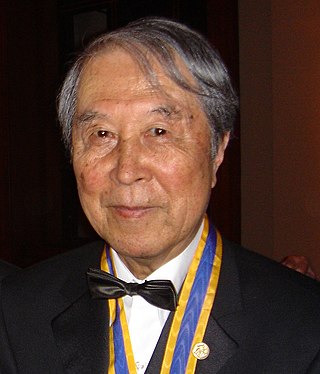Related Research Articles

The International Union of Pure and Applied Physics is an international non-governmental organization whose mission is to assist in the worldwide development of physics, to foster international cooperation in physics, and to help in the application of physics toward solving problems of concern to humanity. It was established in 1922 and the first General Assembly was held in 1923 in Paris. The Union is domiciled in Geneva, Switzerland.

Ashoke Sen FRS is an Indian theoretical physicist and distinguished professor at the International Centre for Theoretical Sciences (ICTS), Bangalore. A former distinguished professor at the Harish-Chandra Research Institute, Allahabad, He is also an honorary fellow in National Institute of Science Education and Research (NISER) India he is also a Morningstar Visiting professor at MIT and a distinguished professor at the Korea Institute for Advanced Study. His main area of work is string theory. He was among the first recipients of the Breakthrough Prize in Fundamental Physics "for opening the path to the realization that all string theories are different limits of the same underlying theory".

John Joseph Hopfield is an American physicist and emeritus professor of Princeton University, most widely known for his study of associative neural networks in 1982. He is known for the development of the Hopfield network. Previous to its invention, research in artificial intelligence (AI) was in a decay period or AI winter, Hopfield work revitalized large scale interest in this field.

Yoichiro Nambu was a Japanese-American physicist and professor at the University of Chicago.
Jeffrey A. Harvey is an American string theorist at the University of Chicago.
The Boltzmann Medal is a prize awarded to physicists that obtain new results concerning statistical mechanics; it is named after the celebrated physicist Ludwig Boltzmann. The Boltzmann Medal is awarded once every three years by the Commission on Statistical Physics of the International Union of Pure and Applied Physics, during the STATPHYS conference.

Helen Rhoda Arnold Quinn is an Australian-born particle physicist and educator who has made major contributions to both fields. Her contributions to theoretical physics include the Peccei–Quinn theory which implies a corresponding symmetry of nature(related to matter-antimatter symmetry and the possible source of the dark matter that pervades the universe) and contributions to the search for a unified theory for the three types of particle interactions. As Chair of the Board on Science Education of the National Academy of Sciences, Quinn led the effort that produced A Framework for K-12 Science Education: Practices, Crosscutting Concepts, and Core Ideas—the basis for the Next Generation Science Standards adopted by many states. Her honours include the Dirac Medal of the International Center for Theoretical Physics, the Oskar Klein Medal from the Royal Swedish Academy of Sciences, appointment as an Honorary Officer of the Order of Australia, the J. J. Sakurai Prize for Theoretical Particle Physics from the American Physical Society, the Karl Taylor Compton Medal for Leadership in Physics from the American Institute of Physics, the 2018 Benjamin Franklin Medal in Physics from the Franklin Institute, and the 2023 Harvey Prize from Technion -- Israel Institute of Technology.
Pierre Ramond is distinguished professor of physics at University of Florida in Gainesville, Florida. He initiated the development of superstring theory.
The John Tyndall Award is given to the "individual who has made pioneering, highly significant, or continuing technical or leadership contributions to fiber optics technology". The award is named after John Tyndall (1820-1893), who demonstrated for the first time internal reflection.

Seifallah Randjbar-Daemi is an Iranian theoretical physicist. He is currently an Emeritus Scientist at the International Centre for Theoretical Physics.
The James Clerk Maxwell Prize for Plasma Physics is an annual American Physical Society (APS) award that is given in recognition of outstanding contributions to the field of the Plasma Physics. It was established in 1975 by Maxwell Technologies, Inc, in honor of the Scottish physicist James Clerk Maxwell. It is currently sponsored by General Atomics. The prize includes a $10,000 USD monetary award and recognition at the annual American Physical Society Division of Plasma Physics conference.
Alexei Yurievich Kitaev is a Russian–American professor of physics at the California Institute of Technology and permanent member of the Kavli Institute for Theoretical Physics. He is best known for introducing the quantum phase estimation algorithm and the concept of the topological quantum computer while working at the Landau Institute for Theoretical Physics. He is also known for introducing the complexity class QMA and showing the 2-local Hamiltonian problem is QMA-complete, the most complete result for k-local Hamiltonians. Kitaev is also known for contributions to research on a model relevant to researchers of the AdS/CFT correspondence started by Subir Sachdev and Jinwu Ye; this model is known as the Sachdev–Ye–Kitaev (SYK) model.
The Fernand Holweck Medal and Prize is a major European prize for Physics awarded jointly every year by the British Institute of Physics (IOP) and the Société Française de Physique (SFP). It is one of the four Grand Prix of the SFP and one of the four International Bilateral Awards of the IOP, consisting of a gold medal and a 3000€ cash prize.
The Max Born Award is given by Optica for "outstanding contributions to physical optics" and is named after Max Born.

The J. Robert Oppenheimer Memorial Prize and Medal was awarded by the Center for Theoretical Studies, University of Miami, from 1969, until 1984. Established in memory of US physicist J. Robert Oppenheimer, the award consisted of a medal, certificate and a $1000 honorarium. It was awarded for "outstanding contributions to the theoretical natural sciences [...] during the preceding decade". The acceptance speech for the inaugural award to Dirac was published as The Development of Quantum Theory (1971).
The Charles Hard Townes Award of Optica is a prize for quantum electronics, including laser physics. Awarded annually since 1981, it is named after the Nobel Prize-winning laser pioneer Charles H. Townes.
The Simon Memorial Prize is an award that honors 'distinguished work in experimental or theoretical low temperature physics'. The prize is awarded by the Institute of Physics and is presented at the International Conference on Low Temperature Physics, which takes place every three years. The prize is named after Francis Simon, who contributed eminently to the field of low-temperature physics. The first prize was awarded in 1959 to Heinz London.
The William F. Meggers Award has been awarded annually since 1970 by the Optical Society for outstanding contributions to spectroscopy. It was established to honor William Frederick Meggers and his contributions to the fields of spectroscopy and metrology.
Gloria Lubkin was an American science journalist and editor for the magazine Physics Today, of which she was the editor-in-chief from 1985 to 1994. She also cofounded the Theoretical Physics Institute at the University of Minnesota and was a fellow of both the American Physical Society and the American Association for the Advancement of Science.
The Paul Dirac Medal and Prize is a gold medal awarded annually by the Institute of Physics for "outstanding contributions to theoretical physics". The award, which includes a £1000 prize, was decided upon by the Institute of Physics in 1985, and first granted in 1987.
References
- 1 2 3 4 5 6 "ICTP honors four with Dirac Medals". Physics Today. 40 (5): 107–108. 1987. Bibcode:1987PhT....40e.107.. doi:10.1063/1.2820038.
- ↑ "Witten and Jones receive Fields Medals for physics-related work". Physics Today. 44 (2): 111–112. 1991. Bibcode:1991PhT....44b.111.. doi:10.1063/1.2810004.
- ↑ "Wolf Prizes go to Ginzburg, Nambu and Moser". Physics Today. 48 (1): 66. 1995. Bibcode:1995PhT....48Q..66.. doi:10.1063/1.2807883.
- ↑ Schwarzschild, Bertram (2008). "Physics Nobel Prize to Nambu, Kobayashi, and Maskawa for theories of symmetry breaking". Physics Today. 61 (12): 16–20. Bibcode:2008PhT....61l..16S. doi:10.1063/1.3047652.
- ↑ "Wolf Foundation honors Wheeler for physics, Keller and Sinai for mathematics". Physics Today. 50 (2): 85. 1997. Bibcode:1997PhT....50Q..85.. doi:10.1063/1.2806531.
- 1 2 "Dirac Medallists 1987 | ICTP". www.ictp.it. Retrieved 2023-10-20.
- 1 2 "Dirac Medallists 1988 | ICTP". www.ictp.it. Retrieved 2023-10-20.
- ↑ "Dirac Medallists 1989 | ICTP". www.ictp.it. Retrieved 2023-10-20.
- 1 2 "Dirac Medallists 1990 | ICTP". www.ictp.it. Retrieved 2023-10-20.
- 1 2 3 "ICTP awards Dirac Medals for work in theoretical physics". Physics Today. 46 (3): 99–100. 1993. Bibcode:1993PhT....46c..99.. doi:10.1063/1.2808851.
- ↑ "Dirac Medallists 1993 | ICTP". www.ictp.it. Retrieved 2023-10-20.
- ↑ "Dirac Medallist 1994 | ICTP". www.ictp.it. Retrieved 2023-10-20.
- ↑ "Dirac Medallist 1995 | ICTP". www.ictp.it. Retrieved 2023-10-20.
- 1 2 "Dirac Medals Announced in Trieste" . Physics Today. 49 (10): 91–91. 1996-10-01. doi:10.1063/1.2807816. ISSN 0031-9228.
- ↑ "Dirac Medallists 1997 | ICTP". www.ictp.it. Retrieved 2023-10-20.
- ↑ "Dirac Medallists 1998 | ICTP". www.ictp.it. Retrieved 2023-10-20.
- ↑ "Dirac Medallist 1999 | ICTP". www.ictp.it. Retrieved 2023-10-20.
- ↑ "Dirac Medallists 2000 | ICTP". www.ictp.it. Retrieved 2023-10-20.
- ↑ "Dirac Medallist 2001 | ICTP". www.ictp.it. Retrieved 2023-10-20.
- ↑ "Princeton Physicist Garners Dirac Medal". Physics Today. 54 (10): 85–85. 2001-10-01. doi: 10.1063/1.1420565 . ISSN 0031-9228.
- ↑ "Dirac Medallists 2002 | ICTP". www.ictp.it. Retrieved 2023-10-20.
- ↑ "Dirac Medallists 2003 | ICTP". www.ictp.it. Retrieved 2023-10-20.
- ↑ "Dirac Medallists 2004 | ICTP". www.ictp.it. Retrieved 2023-10-20.
- 1 2 "Dirac Medallists 2005 | ICTP". www.ictp.it. Retrieved 2023-10-20.
- ↑ "Dirac Medallist 2006 | ICTP". www.ictp.it. Retrieved 2023-10-19.
- ↑ "Dirac Medallists 2007 | ICTP". www.ictp.it. Retrieved 2023-10-19.
- ↑ "Dirac Medallists 2010 | ICTP". www.ictp.it. Retrieved 2023-10-19.
- ↑ "Dirac Medallists 2009 | ICTP". www.ictp.it. Retrieved 2023-10-19.
- ↑ "Dirac Medallists 2010 | ICTP". www.ictp.it. Retrieved 2023-10-19.
- ↑ "Dirac Medallists 2011 | ICTP". www.ictp.it. Retrieved 2023-10-19.
- ↑ "Dirac Medallists 2012 | ICTP". www.ictp.it. Retrieved 2023-10-19.
- ↑ "Dirac Medallists 2013 | ICTP". www.ictp.it. Retrieved 2023-10-19.
- ↑ "Dirac Medallists 2014 | ICTP". www.ictp.it. Retrieved 2023-10-19.
- ↑ "Dirac Medallists 2015 | ICTP". www.ictp.it. Retrieved 2023-10-19.
- ↑ "Dirac Medallists 2016 | ICTP". www.ictp.it. Retrieved 2023-10-19.
- ↑ "ICTP – Dirac Medallists 2017". www.ictp.it. Archived from the original on 2021-03-05. Retrieved 2017-08-08.
- ↑ "ICTP – Dirac Medallists 2018". www.ictp.it. Archived from the original on 2021-02-03. Retrieved 2018-08-08.
- ↑ "ICTP – Dirac Medallists 2019". www.ictp.it. Archived from the original on 2020-10-28. Retrieved 2019-08-08.
- ↑ ""ICTP – Dirac Medallists 2020"". Archived from the original on 2021-08-17. Retrieved 2020-08-15.
- ↑ ""ICTP – Dirac Medallists 2021"". Archived from the original on 2021-08-09. Retrieved 2021-08-09.
- ↑ ""ICTP – Dirac Medallists 2022"". Archived from the original on 2022-08-09. Retrieved 2022-08-09.
- ↑ "Dirac Medallists 2023 | ICTP". www.ictp.it. Retrieved 2023-08-10.
- ↑ Dirac Medallists 2024